
Back to Sidestreet Bannerworks
March 2002
Robins Springs Shays
by Marc Horovitz

I purchased this pair of Shays perhaps 10 or 12 years ago from the obscure French firm of Robins Springs. I know little of the company itself. Usually, I keep all correspondence, but in this case I somehow didn't. I remember, though, that it took many months without communication before the engines arrived. I was told by a third party that this was (is?) a father-son operation and the reason that it had taken so long for the engines to show up was that the father had been ill. By that time I figured I'd been had, so it was a pleasant surprise when they finally did arrive.
These are good-sized locomotives, nominally 1:20 scale, and are freelance in design. Both engines employ the same steam motor, an unusual, single-acting twin with cranks set 180 degrees apart. The valves are run by standard eccentrics and the cylinders are non-reversing. The pistons are long and are connected directly to the drive shafts with wrist pins. The drive train is typical for a Shay, with telescoping square shafts and nicely made U-joints. The gears, though, are another story. Instead of proper bevel gears, these engines have 10-tooth pinions on the shaft and (approximately) 40-tooth, pressed-steel crown gears on the wheels. There is a small amount of adjustment in the journals to keep the gears properly meshing. The wheels are turned up from steel bar and have relatively deep flanges.
A dead-leg lubricator resides in the cab of each. Both boilers are gas fired. The horizontal one has an inner barrel (the boiler proper) and an outer shell, with space between. There is a large, enclosed firebox below that is lit from the off side. The vertical-boilered loco has a single-flue boiler with a large flue. Inside the flue are six water tubes, with a mushroom burner contained in the firebox below.
A gas tank resides in the bunker of each engine. There is not what we have come to know as a proper gas filler valve, but a sort of odd, non-return valve with a ball in it. A screw-on cap actually keeps the gas from leaking out. This system works OK on the horizontal engine, but the vertical one had a leaky control valve and I could not run it without repair.
A toy-engine safety valve is fitted to each loco. The steam line passes directly from the boiler to the cylinders, without benefit of a throttle. These engines are basic indeed. Workmanship varies from pretty good to pretty awful.
Performance
A few days before the run day we had a late-season snowstorm that dumped about 6", so the track had to be excavated for the run. This was done a couple days in advance to allow the sun time to do its work and fully clear the line. Even so, the track was at the bottom of a trench.
As mentioned above, the vertical engine had a gas leak, so couldn't be run. The horizontal loco was oiled all round in the usual way, the lubricator filled, and the boiler filled to about two-thirds with distilled water. The gas tank was filled using a regular adapter. I had to open the gas control valve to bleed the system so that gas would actually enter the tank. By trial and error I was able to fill it.
Once this was done, I set the engine on blocks and lit it up. The first few minutes were a little iffy due to liquid butane getting into the line. The takeoff was evidently too low. Once the gas level had dropped sufficiently and only vaporized gas got to the burner, the fire settled down and burned very well. After a few minutes, steam started coming out of the stack and from a few other places it shouldn't as well. The engine was coming to life.
I gave the shaft a few rotations to see if it wanted to go. It seemed agreeable, so I took it out to the track and gave it a whirl. It ran a foot or two, then stopped. This was repeated two or three times, with intervals for the steam to build again. Finally, the engine took off and ran continuously at a pretty good speed for a Shay. I noticed that only three axles were powered, the fourth having backed off its gear. Nevertheless, the engine ran well. It is a loud runner, with lots of mechanical noise, partly due to the indifferent fit of many of its components.
With no throttle and no reversing, the best one could do is turn it on and stand back to enjoy the run, which is what I did.
|
|
|
| Builder | Robins Springs, France |
| Date built | Circa 1990 |
| Gauge | 45mm (gauge 1) |
| Scale | 1:20 (nominal) |
| Boilers | Both gas fired. Horizontal—enclosed boiler with protective shell and water tubes Vertical—large single flue with six water tubes and mushroom burner |
| Fittings | Safety valve |
| Fuel | Butane gas |
| Blow-off pressure | 20 psi (estimated) |
| Cylinders | Two, single acting, set at 180° |
| Reversing gear | None |
| Lubricator | Displacement |
| Dimensions | Horizontal: 15-1/2" long x 4-1/2" wide x 5-7/8" tall Vertical—13-1/2" long x 4-1/2" wide x 7-5/8" tall |
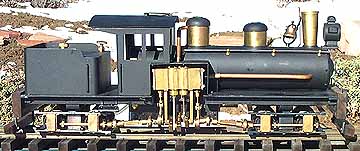
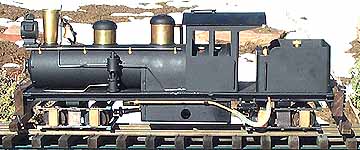
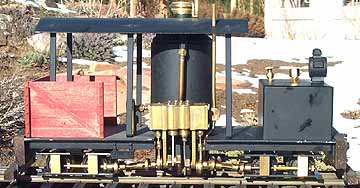
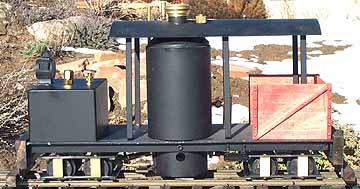

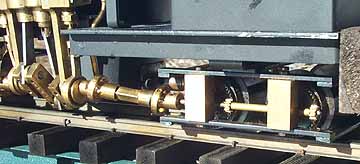
Above: The drive train and gearing can be seen here. Note the pinion gears turning the stamped-steel crown gears.
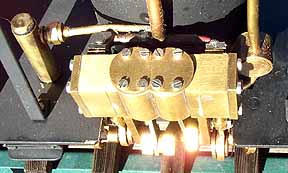
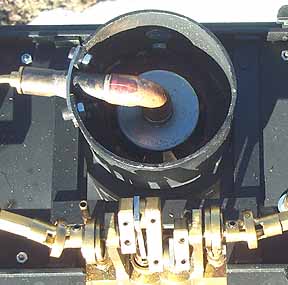
Right: A mushroom burner (seen from below) fires the vertical boiler. There is a single, large flue with half a dozen water tubes inside.
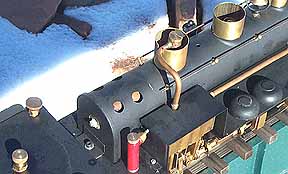
Back to Sidestreet Bannerworks
This page and its contents Copyright Sidestreet Bannerworks, 2002